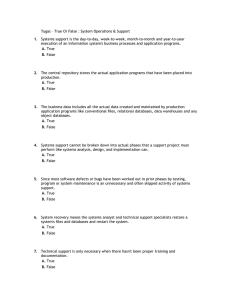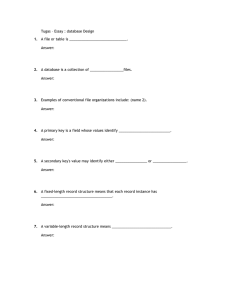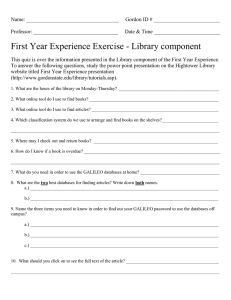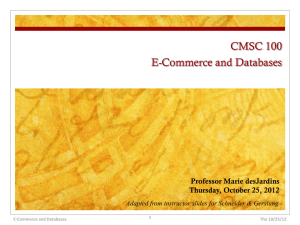E-Busines & E-Commerce Pertemuan 19
advertisement
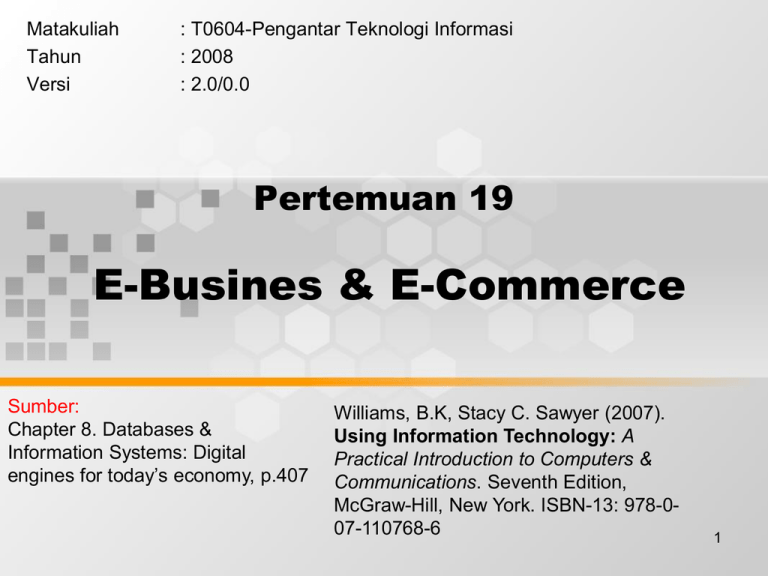
Matakuliah Tahun Versi : T0604-Pengantar Teknologi Informasi : 2008 : 2.0/0.0 Pertemuan 19 E-Busines & E-Commerce Sumber: Chapter 8. Databases & Information Systems: Digital engines for today’s economy, p.407 Williams, B.K, Stacy C. Sawyer (2007). Using Information Technology: A Practical Introduction to Computers & Communications. Seventh Edition, McGraw-Hill, New York. ISBN-13: 978-007-110768-6 1 Learning Outcomes Pada akhir pertemuan ini, diharapkan mahasiswa akan mampu : • Menjelaskan: pengertian e-business dan e-commerce, jenis-jenis e-commerce (C2) 2 Outline Materi • Databases & The Digital Economy: EBusiness & E-Commerce • Using Databases to Help Make Decisions 3 Databases & The Digital Economy • E-Commerce – The buying and selling of products and services through computer networks – Examples of some e-tailers (electronic retailers): • www.amazon.com sells books and music online • www.sees.com sells candy online • www.ebay.com connects buyers with sellers online using online auctions 8-4 Databases & The Digital Economy • Innovative e-tailer technologies make online shopping easier – One-click option • Allows you to click on an item and immediately go to the check-out process – 360-degree images • Allow you to see all sides of an item – Order tracking • Bar codes are assigned to items being shipped that allow customers to check shipping progress via the internet – Shop bots • Are programs that help users search for a particular product of service 8-5 Databases & The Digital Economy • Types of E-Commerce – Business-to-business (B2B) • A business sells to other businesses using the internet or a private network to cut transaction costs and increase efficiencies – Business-to-consumer (B2C) • A business sells goods or services to consumers – Consumer-to-consumer (C2C) • Consumers sell goods or services directly to other consumers with the help of a third party, such as eBay. 8-6 Using Databases to Help Make Decisions • What are the qualities of good information? – Correct and verifiable – Complete yet concise – Cost effective – Current – Accessible 8-7 Using Databases to Help Make Decisions • Most organizations have 6 departments to which information must flow – Research and development – Production (or operations) – Marketing and sales – Accounting and finance – Human resources (personnel) – Information systems (IS) • Information flows horizontally between departments 8-8 Using Databases to Help Make Decisions • Besides the 6 departments, many organizations also have 3 levels of management – Strategic-level management • Top managers concerned with strategic or long-term planning and decisions – Tactical-level management • Middle level managers who make decisions to implement the strategic goals set for the organization – Operational-level management • Low-level supervisors make daily operational decisions • Information flows vertically between management levels 8-9 Using Databases to Help Make Decisions • Decentralized Organizations – a new structure – Employees increasingly telecommute – some staff have no desk or office at work – Employees communicate with each other more via email than in person – Companies use Groupware CSCW (computersupported cooperative work) systems to enable cooperative work by groups of people – The management structure is flattened as employees are given more authority to make day-to-day decisions 8-10 Kesimpulan 11


